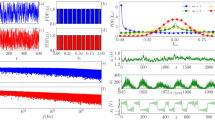Abstract
NONLINEAR forecasting has recently been shown to distinguish between deterministic chaos and uncorrelated (white) noise added to periodic signals1, and can be used to estimate the degree of chaos in the underlying dynamical system2. Distinguishing the more general class of coloured (autocorrelated) noise has proven more difficult because, unlike additive noise, the correlation between predicted and actual values measured may decrease with time—a property synonymous with chaos. Here, we show that by determining the scaling properties of the prediction error as a function of time, we can use nonlinear prediction to distinguish between chaos and random fractal sequences. Random fractal sequences are a particular class of coloured noise which represent stochastic (infinite-dimensional) systems with power-law spectra. Such sequences have been known to fool other procedures for identifying chaotic behaviour in natural time series9, particularly when the data sets are small. The recognition of this type of noise is of practical importance, as measurements from a variety of dynamical systems (such as three-dimensional turbulence, two-dimensional and geostrophic turbulence, internal ocean waves, sandpile models, drifter trajectories in large-scale flows, the motion of a classical electron in a crystal and other low-dimensional systems) may over some range of frequencies exhibit power-law spectra.
This is a preview of subscription content, access via your institution
Access options
Subscribe to this journal
Receive 51 print issues and online access
$199.00 per year
only $3.90 per issue
Buy this article
- Purchase on Springer Link
- Instant access to full article PDF
Prices may be subject to local taxes which are calculated during checkout
Similar content being viewed by others
References
Sugihara, G. & May, R. M. Nature 344, 734–741 (1990).
Wales, D. J. Nature 350, 485–488 (1991).
Tsonis, A. A. & Elsner, J. B. Nature 333, 545–547 (1988).
Essex, C., Lookman, T. & Nerenberg, M. A. H. Nature 326, 64–66 (1987).
Frank, G. W., Lookman, T., Essex, C. & Nerenberg, M. A. H. Physica D46, 427–438 (1990).
Schaffer, W. M., Olsen, L. F., Truty, G. L., Fulmer, S. L. & Graser, D. J. in From Chemical to Biological Organization (eds Marcus, M., Muller, S. C. & Nicolis, G.) (Springer, New York, 1988).
Grassberger, P. & Procaccia, I. Physica D9, 186–208 (1983).
Grassberger, P. & Procaccia, I. Phys. Rev. Lett. 50, 346–349 (1983).
Osborne, A. R. & Provenzale, A. Physica D35, 357–381 (1989).
Theiler, J. Phys. Lett. A155, 480–492 (1991).
Farmer, J. & Sidorowich, J. J. Phys. Rev. Lett. 62, 845–848 (1987).
Casdagli, M. Physica D35, 335–356 (1989).
Rumelhart, D. E., Hinton, G. E. & Williams, R. J. Nature 323, 533–536 (1986).
Wolpert, D. M. & Miall, R. C. Proc. R. Soc. B242, 82–86 (1990).
Anderson, T. W. An Introduction to Multivariate Statistics (Wiley, New York, 1958).
Valis, G. K. Science 232, 243–245 (1986).
Hense, A. Beitr. Phys. Atm. 60, 34–47 (1987).
Author information
Authors and Affiliations
Rights and permissions
About this article
Cite this article
Tsonis, A., Elsner, J. Nonlinear prediction as a way of distinguishing chaos from random fractal sequences. Nature 358, 217–220 (1992). https://doi.org/10.1038/358217a0
Received:
Accepted:
Published:
Issue Date:
DOI: https://doi.org/10.1038/358217a0
This article is cited by
-
Generative learning for nonlinear dynamics
Nature Reviews Physics (2024)
-
Informational predictability, and an application to the intensity of high-resolution temporal rainfall
Stochastic Environmental Research and Risk Assessment (2023)
-
Ordinal patterns-based methodologies for distinguishing chaos from noise in discrete time series
Communications Physics (2021)
-
Effect of the thematic resolution of land use data on urban expansion simulations using the CA-Markov model
Arabian Journal of Geosciences (2020)
-
Exploring chaotic attractors in nonlinear dynamical system under fractal theory
Multidimensional Systems and Signal Processing (2018)
Comments
By submitting a comment you agree to abide by our Terms and Community Guidelines. If you find something abusive or that does not comply with our terms or guidelines please flag it as inappropriate.



